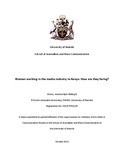| dc.description.abstract | The media are at the forefront of admonishing societal ills, including discrimination against women. However, turning the spotlight on their operations and environment, do the media live up to the ideals they preach on the cause for the advancement of women?
Statistics from various studies show that women are under-represented in the media industry in Kenya, yet there is no shortage of competent women professionals in the field: four out of every five graduates from journalism or media faculties are in fact women. This under-representation is even more pronounced at the apex: in senior management and governance, the ratio of men to women is 2:1, and the two largest media houses have never had a woman CEO.
This begs the question: Is ‘womanity’ positive or negative capital in the media workplace? Is the media sector woman-friendly? Does the industry actively seek gender parity? Are women employees valued?
This study examines these and related questions, through quantitative and qualitative analyses on the done by various researchers over the last two decades. The questions are examined using Pierre Bourdieu’s theories on capital, as interpreted by Toril Moi and applied by Monika Djerf-Pierre. The image that crystallises on this reversed mirror is disturbing, at odds with what the ‘preacher preaches’. The ‘glass ceiling’ is intact, the ‘velvet ghetto’ undemolished and a ‘Barbie-doll boudoir’ has emerged. The media sector is far from being woman-friendly; it is still largely a man’s world: sexual harassment and sexist language are rampant – with women-based sexualisation of content now added. The ‘boys’ clubs’ and networks remain intact. All these factors militate against the advancement of women.
But there is hope if only because some women have overcome these barriers, and so others too can. This study makes several recommendations on areas warranting further research and action, to counter the anti-woman culture in the media sector and remedy the undesirable prevailing situation. | en_US |

